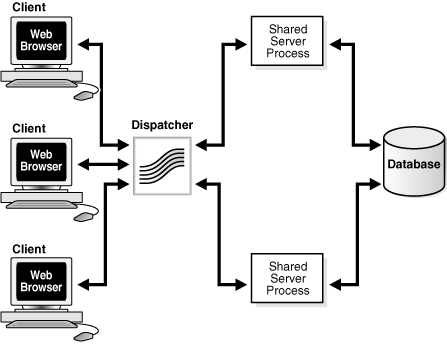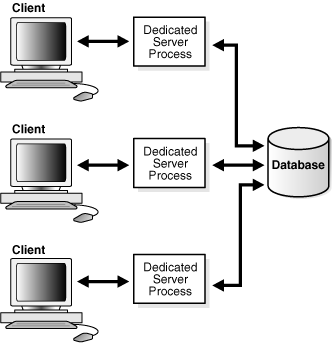1.1.3 Understanding Shared Server Architecture
The Oracle Database shared server architecture increases the scalability of applications and the number of clients that can simultaneously be connected to the database. The shared server architecture also enables existing applications to scale up without making any changes to the application itself.
When using a shared server, clients do not communicate directly with a database server process, a database process that handles a client's requests on behalf of a database. Instead, client requests are routed to one or more dispatchers. The dispatchers place the client requests in a common queue. An idle shared server from the shared pool of server processes picks up and processes a request from the queue. This means a small pool of server processes can serve a large number of clients.
The Shared Server Architecture and Dedicated Server Architecture figures show the basic difference between the shared server connection model and the traditional dedicated server connection model. In the shared server model, a dispatcher can support multiple client connections concurrently. In the dedicated server model, there is one server process for each client. Each time a connection request is received, a server process is started and dedicated to that connection until completed. This causes a processing delay.
A shared server is ideal for configurations with a large number of connections because it reduces the server memory requirements. A shared server is well suited for both Internet and intranet environments.
Utilization of server resources can be further enhanced with Oracle Connection Manager. Oracle Connection Manager, an Oracle Net Services component, enables multiple client network sessions to be multiplexed, or funneled, through a single network connection to a database.
The session multiplexing feature reduces the demand on resources needed to maintain multiple network sessions between two processes by enabling the server to use fewer network connection endpoints for incoming requests. In this way, the total number of network sessions that a server can handle is increased. One Oracle Connection Manager with multiple gateways enables thousands of concurrent users to connect to a server.
The following figure shows how session multiplexing can be used in a web architecture. When Oracle Connection Manager is run on the same computer as an application web server, the application web server can route multiple client sessions through Oracle Connection Manager to ensure that those sessions have continuous access to an Oracle Database server. This functionality is especially useful for web applications where session availability and response time are major concerns.
The following are the advantages and disadvantages of session multiplexing. Session multiplexing is recommended for networks where continuous connectivity is required.
Advantages of Session Multiplexing
-
Limits the number of network resources used for each process
-
Supports large client populations
-
Maximizes the number of client/server sessions over a limited number of process connections
-
Optimizes resource utilization
-
Enables identification and monitoring of real users
-
Enables mid-tier applications to support additional services
-
Requires only a single transport for clients with multiple applications
-
Requires only a single network connection for database links
Disadvantage of Session Multiplexing
Clients must connect to Oracle Connection Manager.
Parent topic: About Oracle Net Services


